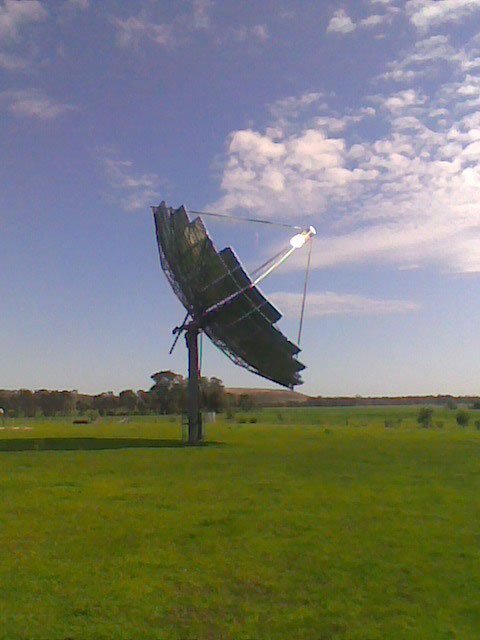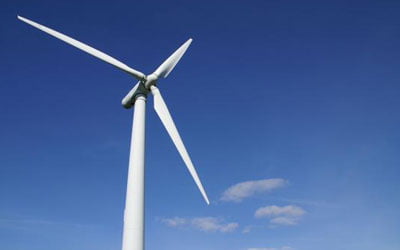This post is a summary of an article I wrote for the AMTIL Australian Manufacturing Technology magazine.
And here is a picture taken of a Solar Systems concentrated Solar Power Dish. We were involved in software upgrades to the dish controller. It produced 114KWhr of power on an August day at Fosterville, near Bendigo and this picture was taken on that day.
Energy Storage
The biggest issue with electricity is that it is hard to store. The Electrical Grid delivers power on demand and manages the generators to maintain the frequency and voltage while delivering the required power to satisfy the demand. Quite a juggling act. And while there are schemes like the Snowy Mountains Hydro where we can pump water uphill to consume power then let it flow downhills and run turbines to produce power, most power is managed at the generator directly.
Wind Power, Solar Photo Voltaic and Solar Concentrated are the primary renewable energy sources we will look at here, and they all provide a fluctuating supply. You can’t easily crank them up or down with the demand. So we still need a base supply to do the balancing act. Depending on our approach, it is estimated that the limit for these fluctuating supply types is between 8% and 30% of the total grid capacity.
Carbon Footprint
This represents how much carbon is releases into the atmosphere for a particular activity. The top emitters of carbon are:
- livestock, principally sheep and cattle
- power generation
- transport (road, rail, air, sea)
- industrial processes
- land clearing, deforestation and agriculture
In Australia, 50% of our emissions come from power generation as we use a lot of brown coal which also happens to be one of the most polluting ways to generate power on mass. This is followed closely by transport. So you can see why power generation and transport are primary focuses for improving our carbon footprint.
There are only a few ways to improve this. These are:
- use less power – which creates the opportunity for more energy efficient devices to be created or alternative ways of doing things such as the use of smarter appliances that conserve energy use or even cooperate with the grid to use power at the best possible time
- reuse existing energy – heat exchangers in air conditioning systems are an example of this
- create energy in more efficient ways – new generator technologies or moving from dirtier sources to cleaner sources
- create energy in ways that does not use carbon, or uses a lot less of it
Because in Australia the creation of electricity is our primary source of greenhouse emissions we will focus on this area for the rest of the article.
Australia is ranked 5th in overall greenhouse gas emissions per capita and we are the highest per capita emitter of the industrialised nations so it is in our interest to develop alternatives to our current high emitting energy infrastructure. This is also where some major manufacturing opportunities arise for Australian industries.
Australian Manufacturing Opportunities
One of the leading contributors to greenhouse gas emissions is sea freight. So the classic Australian model of digging it up, shipping it overseas and shipping value added goods or materials back is a poor strategy when you consider the greenhouse gases produced. There will be an increasing advantage of doing the value add locally when reducing the total carbon footprint becomes important.
Here are some examples of successful local manufacture of alternative energy products in Australia today. This is a very cursory list:
- Australian Solar Manufacturing is importing silicon cells and manufacturing complete TUV approved panels in Hallam, Victoria.
- Solar Systems are world leaders in concentrated solar silicon photovoltaics and are putting together the world’s largest concentrated solar electric facility in Mildura.
- Latronics and Solar Energy Australia both locally manufacture grid tied central inverters
Here are some opportunities to consider in the near future. This is just scratching the surface:
- BP Solar are working with the CSIRO on deep discharge lead acid batteries for use in energy storage for remote solar installations. This will lead to new battery technology and new manufacturing opportunities.
- CSIRO are world leaders in organic photovoltaics and organic semiconductors. VICOSC is established to commercial the organic photovoltaics and there will be many opportunities that come from this initiative.
- Existing mounting and installation hardware for photovoltaics is labour intensive to use. There are opportunities for smarter and more elegant systems to make installation more modular and straight forward. This can work with local or imported panels.
- Most grid connected inverters are imported but there are concerns about both build quality and whether they are all compliant with Australian Standards. The world market for inverters is set to grow by a factor of 10 over the next 5 years so there are also export opportunities.
- Biofuels will become increasingly more important and there will be many opportunities related to this at both the production and consumption end of the process.
As you can see from the list, there are opportunities in both the core technology manufacture and also in the supporting systems and hardware.
Ray Keefe has been developing high quality and market leading electronics products in Australia for nearly 30 years. For more information go to his LinkedIn profile at Ray Keefe. This post is Copyright © 2011 Successful Endeavours Pty Ltd.





